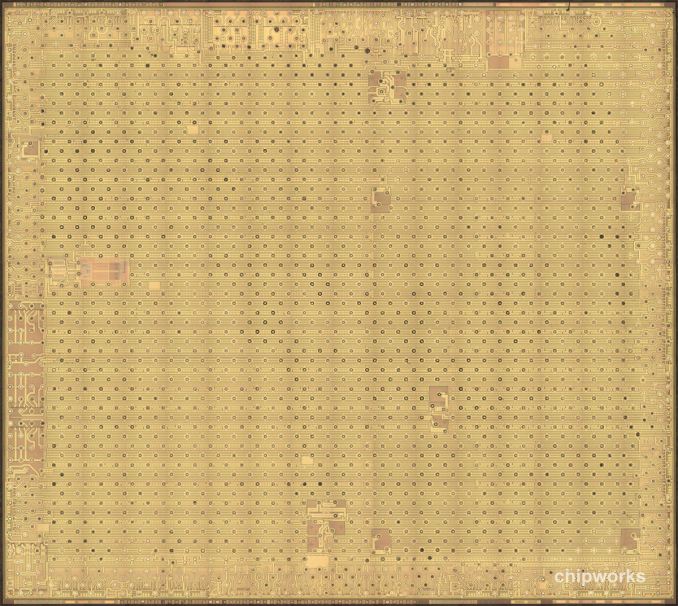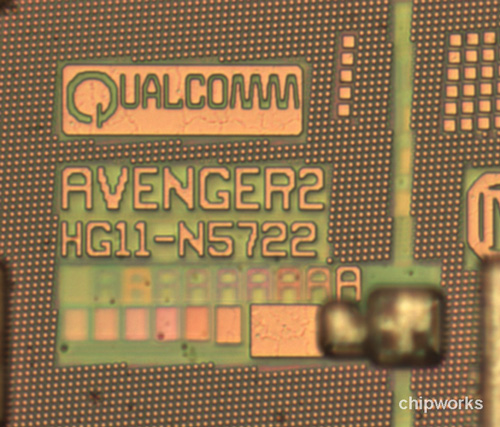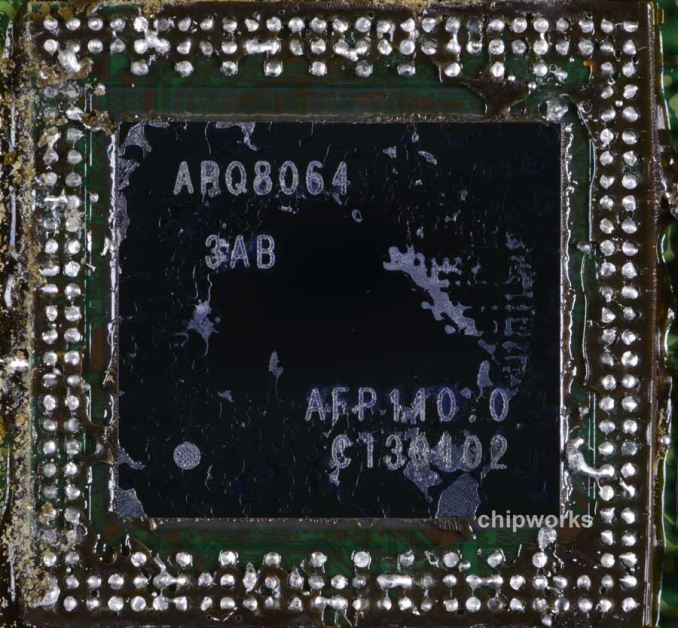Samsung Galaxy S 4 Review - Part 1
by Brian Klug on April 24, 2013 12:01 AM ESTGalaxy S 4 - Powered by a Better Snapdragon 600 (APQ8064AB)?
At a high level, Samsung's Galaxy S 4 integrates Qualcomm's Snapdragon 600 SoC. From what Qualcomm told us about Snapdragon 600, we're dealing with four Krait 300 cores and an Adreno 320 GPU. The Krait 300 cores themselves are supposed to improve performance per clock over the original Krait CPU (Krait 200) through a handful of low level microarchitectural tweaks that we've gone through here. The Krait 300 design also allegedly improves the ability to run at higher frequencies without resorting to higher voltages. This isn't the first time we've talked about Snapdragon 600, but since then a few things have come to light.

Snapdragon 600 from HTC One - Chipworks
For starters, Chipworks got their hands on a Snapdragon 600 SoC (from an HTC One) and delayered the SoC. In its investigation, Chipworks discovered that Snapdragon 600 had the exact same die area as the previous generation Snapdragon S4 Pro (APQ8064). Also, although you'd expect APQ8064T markings on the chip itself, the part carried the same APQ8064 label as previous S4 Pro designs.

Avenger 2 Markings on Snapdragon 600 die from HTC One - Chipworks
Chipworks did note however that there were some subtle differences between a standard APQ8064 and the Snapdragon 600 SoC from the HTC One. The Snapdragon 600 from the One is labeled with an Avenger2 codename rather than Avenger, the latter was apparently present on prior APQ8064 designs. Chipworks also noticed differences in the topmost metal layer, although it's not clear whether or not they stopped there or found no differences in lower layers.
All of this points to a much more subtle set of physical differences between APQ8064 and the earliest Snapdragon 600s. Metal layer changes are often used to fix bugs in silicon without requiring a complete respin which can be costly and create additional delays. It's entirely possible that Krait 300 was actually just a bug fixed Krait 200, which would explain the identical die size and slight differences elsewhere.
That brings us to the Galaxy S 4. It's immediately apparent that something is different here because Samsung is shipping the Snapdragon 600 at a higher frequency than any other OEM. The Krait 300 cores in SGS4 can run at up to 1.9GHz vs. 1.7GHz for everyone else. Curiously enough, 1.9GHz is the max frequency that Qualcomm mentioned when it first announced Snapdragon 600.
Samsung is obviously a very large customer, so at first glance we assumed it could simply demand a better bin of Snapdragon 600 than its lower volume competitors. Looking a bit deeper however, we see that the Galaxy S 4 uses something different entirely.
APQ8064 from a Snapdragon 600 based HTC One - Chipworks
Digging through the Galaxy S 4 kernel source we see references to an APQ8064AB part. As a recap, APQ8064 was the first quad-core Krait 200 SoC with no integrated modem, more commonly referred to as Snapdragon S4 Pro. APQ8064T was supposed to be its higher clocked/Krait 300 based successor that ended up with the marketing name Snapdragon 600. APQ8064AB however is, at this point, unique to the Galaxy S 4 but still carries the Snapdragon 600 marketing name.
If we had to guess, we might be looking at an actual respin of the APQ8064 silicon in APQ8064AB. Assuming Qualcomm isn't playing any funny games here, APQ8064AB may simply be a respin capable of hitting higher frequencies. We'll have to keep a close eye on this going forward, but it's clear to me that the Galaxy S 4 is shipping with something different than everyone else who has a Snapdragon 600 at this point.











335 Comments
View All Comments
Roffles12 - Wednesday, April 24, 2013 - link
fans of the solid aluminum chasis are a very vocal and illogical minority. very annoying in fact. i have yet to hear any logical argument for why it's better. "it feels nicer in the hand" isn't a reason, but rather a completely subjective opinion. by my logical observation, the aluminum phones are actually more fragile and prone to scratching. aluminum is also more rigid which means it will have greater energy transfer on shock impact, resulting in a greater chance of shock energy transferring to the screen, thus damaging it. you're almost forced to purchase a case to protect it.i think the sales figures for the gs3 alone show that most people don't care if their phone looks like a piece of jewelery. please save your opinions of vanity for the imaginary fashion show in your head. i much prefer polycarbonate plastics for logical reasons. i've been using my gs3 for a year without a case and it looks just like new. if i want to be flashy, i'll wear my nicest watch. my phone is for functionality, so the gs3's build is par for the course. The 45 total second battery swap of a GS3/4 (thanks for flexible plastics) compared to 3.7 hour charging for the HTC One (thanks to a solid metal frame) is all that really needs to be said on the matter. case closed. argument over. shup up. go away.
Crono - Wednesday, April 24, 2013 - link
I like how you dismiss a view as being "a completely subjective opinion", then proceed to give your opinion, " i much prefer polycarbonate plastics", and conclude with a rather immature and unconvincing, "shup up. go away."Truth is some people prefer a solid aluminum body for the same reason one might prefer a more aesthetically premium vehicle. A phone is a tool, but when you are talking about high-end specs - and the GS4 is only marginally better CPU-wise in real-world, observable performance, about equal in other areas, and lower in some - a better quality chassis might make the difference.
I don't care if someone prefers the GS4 for whatever reason, but stop pretending (and apparently you are by virtually putting your fingers in your ears with that last comment) that Samsung doesn't make cheaper casing and without offering a lower price for the end consumer.
It's not even the fact that it's plastic or polycarbonate or whatever you want to call it, as Nokia and HTC make quality plastic bodies. There isn't a good excuse for cheap looking and feeling bodies, even if it's semi-durable without a third party case. This isn't the equivalent of an econobox in the car world, the Galaxy commands a high price.
If you really are satisfied with the Galaxy line, then feel free to complain when Samsung finally gets the message and decides to make truly premium-bodied phones: because they eventually will have to if HTC succeeds with the One.
Roffles12 - Wednesday, April 24, 2013 - link
There is nothing subjective about the fact that polycarbonate plastics and a better material choice for a hand held daily use device than aluminum because of its durability, elasticity, ability to absorb shock and ability to shape into different sizes and thickness while still maintaining those superior properties. I was obviously commentating on the weaknesses of aluminum in CONTRAST to polycarbonate materials. If you can't read between the lines of my comment and apply some common sense, then you need to go back to school. I'm done with you... go back to the verge where you can all have a circle jerk with your fragile tech jewelery.RealityMonster - Monday, April 29, 2013 - link
Actually, that's entirely subjective. The energy transfer argument is really only meaningful when you're talking about a device with moving parts or parts that are likely to break off because of the shock. The plastic back isn't really going to help the screen very much (that is, if the phone falls on its back, the screen isn't going to break, and if it falls on its front, the back isn't going to help), and there are very few parts inside the phone that are likely to move much at all given the impact. In fact, I see people with phones that have busted glass all the time, and the phone itself is still working. (I've seen both an SGS3 and an iPhone 4 working this way.)Plastic is more likely to shatter on impact (which is to say plastic shatters and aluminum won't), and if the plastic back falls and cracks, it probably won't snap back on anymore. On the MOHS hardness scale, aluminum is definitely higher than plastic, which means there are fewer things that can scratch it.
Maybe you don't think it's important what the body material is, but I don't think your bias against aluminum is particularly justified. Aluminum is going to have structural rigidity that the polycarbonate doesn't have, which is why you can use it structurally on the outside of the phone.
I'd actually like to know what the relative carbon footprint of the two materials is. On the one hand, aluminum has to be mined and machined, but plastic all comes from oil and I don't know if it's recyclable in this form. That's the sort of thing that I think is important.
Thegonagle - Wednesday, April 24, 2013 - link
Jeez, that's kind of like saying "it's annoying that people buy Cadillacs when Chevys do the same thing." It's a matter of style and differing taste.Kutark - Thursday, April 25, 2013 - link
Isn't rampant fanboism grand ;-).blau808 - Wednesday, April 24, 2013 - link
Giving up MicroSD and removable battery just for aluminium? Pffft.dyc4ha - Wednesday, April 24, 2013 - link
Why is it so hard for you people to understand that not everyone (I am comfortable in saying the majority) uses up ALL 32GB on their phone. Removable battery/External battery pack, both involves carrying an extra piece. I dont see the big difference here. Actually with the battery pack I can have undisrupted continuous use whereas removable battery requires that I switch off the phone and then replace the battery.jeffkibuule - Thursday, April 25, 2013 - link
Not only that, in order to charge the battery, it has to be in the phone. POINTLESS.ojchurch - Friday, April 26, 2013 - link
Have you never heard of external battery chargers?With an extra battery I can use my phone for 7/8 hours at work for updating spreadsheets, pdfs etc. on a building site with limited access to power and still have a spare battery for use in the evening. Or have a more "normal" usage pattern and not charge the phone for a couple of days. You have more freedom in how you can use your phone.